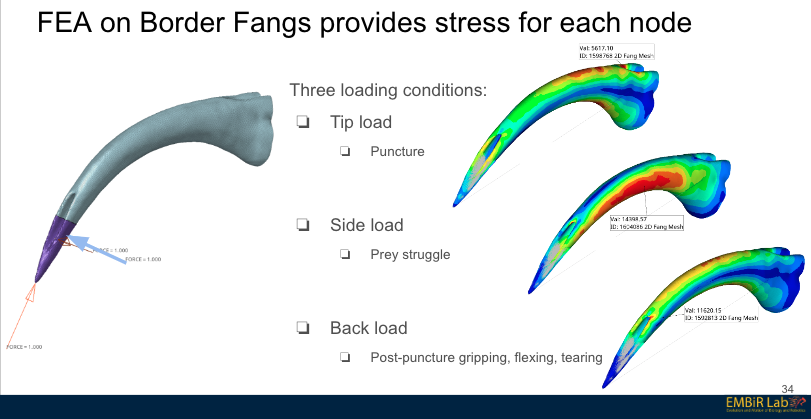My research involves discovery, modeling, and design for comparative biomechanics and bio-inspired robotics. I develop new information-based methods to analyze the behavior and locomotion of animals in natural environments and use laboratory-based experiments to build detailed models of how animal motion is generated by muscles, tendons, and bones. I’ve developed machine learning methods to automatically segment non-standard animals in photographs for taxonomically-broad phylogenetic comparative analyses of color pattern and behavior. I also use Finite Element Analysis to understand how the evolution of 3-dimensional shape in animal bones and teeth have adapted to a variety of ecological situations, such as novel substrates or diet.
Because FEA and other biomechanical methods are so computationally intensive, I’ve adopted a surrogate model approach that uses Bayesian Optimization to perform stimulus selection and make accurate predictions of sample performance with the minimum number of model datapoints. I’ve also begun applying this surrogate model approach to explore the design space of bio-inspired grippers made from dielectric fluid actuators. Data-driven modeling also informs the design rigid legged robots in my lab, which we will use to test hypotheses regarding how limb shape affects overall locomotion.

Additional Information
What are some of your most interesting projects?
Jerboas are bipedal desert rodents that hop erratically with zig-zag trajectories when they are escaping from predators (some describe them as “ricochetal”). These animals are about the size of your fist, but they can jump over 3 feet straight up in the air or forwards. Little was known about their locomotion, and the majority of biomechanical locomotion research was performed in lab environments on treadmills. However, training an animal to run on a treadmill reduces the variability in direction and speed that the animals would need to survive in the wild. So I went out into the desert and filmed these animals jumping and running on their natural substrates.
To understand how these trajectories might confound predators, I measured the unpredictability (or entropy) and found that bipedal desert rodents are much less predictable than quadrupedal desert rodents. Then, taking a closer look using high-speed video cameras, I determined that they have at least 5 distinct bipedal gaits. Using both kinematic and dynamic data, I built a modified Spring-Loaded Inverted Pendulum model with a torsional spring to control the neutral leg swing angle. I then performed a numerical search using a continuing approach to test neighboring parameter values for viability to discover bifurcations in gait structure. I found that by decoupling the neutral leg swing angle between left and right legs, the model was capable of transitioning between gaits across the entire speed range, just as the real jerboas do. This research will be used to inform the design of controllers for legged robots to switch gaits smoothly across a wide range of speeds.
How did you end up where you are today?
I started off not knowing at all what I wanted to do, but enjoying martial arts. A friend told me to check out the biomechanics class in my last year in undergrad at UC Berkeley, and I was hooked! I joined the lab immediately and worked there for two years after graduating. I wanted to learn everything, so I worked on a different project with a different graduate student every day of the week. During that time, I worked with cockroaches, geckos, iguanas, and agama lizards, learning about how they generate and control their motions. I was also lucky to get hands-on experience with designing and building bio-inspired robots and using them to test biological hypotheses to reveal fundamental principles of animal locomotion.
After that, I went on to study biomechanics and evolutionary biology at Harvard, where I was introduced to jerboas for the first time. They are such strange and wonderful creatures that I knew I wanted to study them for the rest of my life. I came to UM in 2015 and worked as a postdoc in Ecology and Evolutionary Biology, where I developed a new modular ethogram system to analyze snake anti-predator behaviors and design snake-mimicking soft robots. Then I became a Research Scientist in the Robotics Institute, followed by being hired as an Assistant Professor in Mechanical Engineering in January of 2021. Now I am appointed in both Robotics and Mechanical Engineering and have affiliations with Ecology and Evolutionary Biology and the Museum of Zoology.
What is the most significant scientific contribution you would like to make?
I really want to build tools to bridge the gap between biology and engineering. So many biological questions are constrained by the technology we have available. By forming connections between these fields, I have already facilitated more quantitative study of non-steady-state locomotion in natural environments. There is also a big gap between what motions animals and robots are capable of performing. I hope to learn strategies from animals and design robots to succeed in unstructured and complex environments.
What makes you excited about your data science and AI research?
I’m extremely excited that data science is making it possible to analyze the types of large datasets that we can collect from animals. There is no limit to the amount of data you can collect about animal locomotion, behavior, appearance, or structure, and the types of studies that used to take decades can now be done in a semester thanks to data science and AI. This makes it possible to integrate information from multiple different data streams and understand more complex relationships between animals, their environments, and how these relationships change through space and time.
What are 1-3 interesting facts about yourself?
I’ve done fieldwork in Malaysia, China, Australia, California, the Bahamas and Peru. I think it’s incredibly important to examine animals in their natural habitats, because our assumptions about their behaviors might be totally wrong if we only see them in zoos or labs.
The first sentence I try to learn in every language is “Where is the bathroom?”
My two rules for fieldwork are: 1) Never stop moving and 2) Never sit down or lean on anything.
